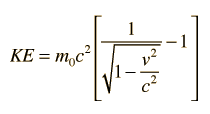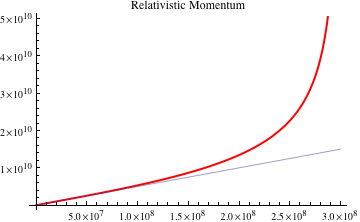 It wasn't that I was a precocious young sprout. Rather that the text of this book was just so damn clear and accessible that even a 6th grader could follow it.
It wasn't that I was a precocious young sprout. Rather that the text of this book was just so damn clear and accessible that even a 6th grader could follow it.Well, after reading through the book a few times, I realized I could compute just how much fuel the starship Enterprise needed to zoom around in space.
Well, actually, no. I didn't know about the square root of minus one yet. I also had no solid figures on what the equivalent to specific impulse a warp plasma using a dilithium conversion of matter/antimatter explosion was.
 |
| Relativistic Kinetic Energy |
Imagine my disappointment, when my figures indicated a fuel tank full of liquid hydrogen approximately ten times the volume of the USS Enterprise.
Well, my sixth grade calculations were off just a bit. Really more like a fuel tank a thousand times the volume of the Enterprise. Nevertheless, I was quite disillusioned with the show.
(I think that was also the year I figured a loving personal God was also probably not in the offings as well. At least, no God worth worshiping. But that was done strictly via good old fashioned logic and scholasticism. So, two birds with one stone, basically).
But the graph for relativistic momentum provided me with a new epistemological metaphor for science and technology and truth. See? The closer you get to absolute truth, the harder it gets to get there. That particular mental model stuck with me well through high school, until I got to college.
No, I did not become a postmodern relativist butthead, thank you. I just realized that:
1) There may be no such thing as absolute truth
2) If such a thing exists, the path to it may be not so straightforward and direct
3) There's always going backwards, backtracking, dead ends, blind alleys, and wild goose chases
4) Even if you manage to struggle to the top of one mountain, there's a whole new, much bigger range on the horizon.
Now what do I think about stuff like this?
I think... I think I need a nap.


Seascape dude. Fitness seascape, with feedback.
ReplyDelete